 |
ΤΗΕ ARCHANGEL MICHAEL
Protaton, Karyes Mount Athos. Work of Manuel Panselenos (1290). The commander-in-chief of the heavenly hosts is represented midway between "heaven and earth" - immaterial and real - dressed in military uniform and girded about with a golden belt, bearing in his hands poles topped by axes and spears (Dionysios of Phournas). "I purposed to sing you a canticle befittingly, but I have nothing immaterial." In Phrygia of Asia Minor a heresy of angel worship developed, and from there it spread to Syme in the Dodecanese in honor of the Angels and of the Archangel Michael in particular (Monastery of the Archangel Michael of Panormites, Michael Roukouniotes et. al.). There is also a large shrine in Mantamados, Mytilene.
|
 |
THE ARCHANGEL GABRIEL
The archangel who brought to the All-holy Lady the joyful message, addressing her with the well-known salutation "Rejoice, O thou full of grace...". He appeared to a monk in the "Vale of Song" near Karyes and chanted the hymn "It is truly meet" before the icon of the All-holy Lady (the miracle is dated at June 11th, 982 A.D.). From that time on, the wonder-working icon was called by this name and became the focal point of Mount Athos. Today it is located in the Sacred Bema of the Protaton.
|
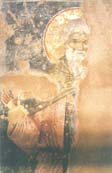 |
SAINT JOHN OF THE LADDER
This fresco has undergone much damage. The professor of the ascetic life, author of the Ladder leading to heaven, lived in asceticism in the 6th century at Mt. Sinai, during the reign of Justin II (565-578). His famous work, considered the "gospel" of monks, was written upon the request of Abbot John of Raitho (contemporary Tour). The monks of Saint Catherine's of Sinai made him their Abbot, but, accustomed to the solitary life, he soon abandoned the monastery of his own accord and returned to his seclusion in the desert. He is portrayed in profound old age.
|
 |
The head of Saint John of the Ladder, a detail of work no. 33. The damages to the fresco created something like a veil of mist around the hermit and blessed solitary. One feels that the saint himself, as always, wanted to insulate himself in this way from the eyes of the world.
|
 |
SAINT THEOKTISTOS
This fresco is quite damaged. Fortunately the face of this fellow ascetic of Saint Euthymios, the great monk Theoktistos, who enclosed himself in a cell of the lavra at Pharan, six miles from the city of Jerusalem, is preserved. After Theophany, he and Saint Euthymios, who lived in asceticism in the same lavra, would depart for the desert, where they lived in great hardship. They would return to the lavra on Palm Sunday. After five years they went and lived in a cave in the desert. But their fame had spread so much, that many disciples followed after them, such that a cenobium was created with Saint Thektistos as abbot. He passed away in 451. Anastasios the Patriarch of Jerusalem presided at his funeral, in which Saint Euthymios the Great took part.
Imprinted in the saint's glance is all the austerity of his ascetic life.
|
 |
SAINT NEILOS THE ASCETIC
According to Sophronios Eustratiades, Saint Neilos was eparch of Constantinople during the reign of Theodosios II (408-450).
Together with his wife, the mother of their two children, he went to Alexandria, where they separated. Saint Neilos took their son, Theodoulos, with him to Mount Sinai, and his wife took their daughter. At Sinai Theodoulos was seized and carried off by barbarian raiders. Living in severe asceticism, the saint spent his time writing ascetical works. His holy relics were transferred during the reign of Justin (518-527) and placed in the church of the Apostle Paul in the orphanage by the same name in Constantinople.
In Panselenos' fresco the impression is given that he is lamenting the loss of his son Theodoulos. The waviness of his long beard is characteristic. Morphologically this portrayal corresponds to that of Saint Theoktistos.
|
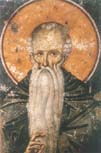 |
SAINT EYTHYMIOS THE GREAT
He was born in 377, at the time of Gravianos (375-383), in Melitene, Armenia. He followed the course toward priesthood to which he had been dedicated by his devout parents, Paul and Dionysia, who previously had been childless for many years. He left Melitene for Jerusalem, where he enclosed himself in the Pharan lavra with Saint Theoktistos as one of his fellow ascetics, and with whom he departed into the desert (see no. 35). He passed away in 473 at the age of 97, during the reign of Leon the Great (457-474), after having converted many Saracens to Christianity.
He is portrayed by Panselenos in his ripe old age, with a long beard and a venerable appearance.
|
 |
SAINT DANIEL THE STYLITE
St. Daniel was from the village of Marutha in Mesopotamia. He became a monk at a young age and followed a strict ascetic life. He took the blessing of Saint Symeon the Stylite (see no. 39) and moved to Constantinople during the reign of Leon the Great (457-474). There he ascended his column and lived the rest of his life upon it.
He is represented with long hair, a long beard and a serene gaze.
|
 |
SAINT SYMEON THE STYLITE
He was born in the hamlet Sisan of Antioch, of parents who were poor shepherds. During the time of Leon the Great (457-474), when Martyrios was Patriarch, he departed for the Monastery of Mandra, where he lived a whole decade. After a three-year stay in the hamlet of Telaniso, he decided to become a stylite and exercised this ascetic way for 47 years. The Alexandrian poet Constantine Cavafy cherished great admiration for him and dedicated a poem and a prose piece to him. "That great man", notes the poet, "that excellent saint, surely constitutes a topic that should be singled out within ecclesiastical history, to be admired and studied. He was perhaps the only person who really dared to live entirely alone."
He is portrayed with his monastic cowl.
|
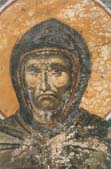 |
SAINT EPHRAIM THE SYRIAN
All the wildness of the desert is mirrored in this representation of the leading neptic father of Syria. Near him in his hermitage, not far from Edessa, Syria, a multitude of disciples and visitors came to hear his words, sweet as honey. His ascetic writings were translated into Greek from Syrian and widely distributed. He passed away in 373.
He is portrayed as a lean old man with a sparse beard, wearing a hood (Dionysios of Phournas).
|
 |
SAINT ATHANASIOS THE ATHONITE
Ο Saint Athanasios the Athonite, an old man, bald with a divided beard, is considered the founder of cenobitic monasticism on Mount Athos. Born in Trapezounta, he led the ascetic life first in Olympus of Bithynia, in the lavra of Michael Maleinos. From there he moved to Athos and in 963, with the help of the Emperor Nicephoros Phocas, he founded the oldest monastery of the Mountain, Megisti Lavra. As Eustratiades mentions, "during the construction of the apse of the sacred bema of the church, ascending to oversee the completed works with six of his disciples, the apse collapsed within the church so that he and his disciples were thrown down, and he met with a tragic death inside the church, where his tomb is."
|
 |
The head of Saint Athanasios the Athonite, a detail of work no. 41. In the form of the father of Hagiorite monasticism Panselenos sets down all the reverence of the hagiorites toward their spiritual forefather.
|
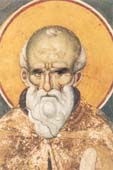 |
SAINT MAXIMOS THE CONFESSOR
During the time of Constans the monothelite he was exiled to Thrace and afterwards to Chersona, because he opposed the heresy. He belonged to the Church of Rome. He is an important father of the Church and a very significant author. In his face the asceticism of his character is imprinted.
|
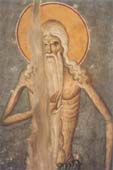 |
SAINT PETER THE ATHONITE
The "grandfather" of hagiorite monasticism, when the ascetics of Athos were hermits. He lived on chestnuts and was dressed in animal skins. The representation of Saint Peter refers to the hermits of the time before Saint Athanasios the Athonite. "In the first decades of the 9th century", writes Dionysia Papachrysanthou, "in a desolate part of Athos, the relics of a hermit were discovered. Certainly, in the same area the recollection of an ascetic bearing the name of Peter had been preserved; the identification between the discovery and the memory of the ascetic occurred automatically and perhaps justifiably, and immediately, or a little later, the monks of that area attributed honor to the relic during the worship services."
|
 |
SAINT NIKON «PREACHER OF REPENTANCE»
He belonged to an important family of Armenia. As a young man he became a monk and travelled around to cities, villages and monasteries, everywhere preaching saving repentance, with the exhortation "Repent", which follows his name as a nickname. He reached as far as Crete and the Peloponnese. In Laconia he erected the church of the Saviour and spent the rest of his life there.
A venerable priestly figure, he is represented by the artist as performing his saving work.
|
 |
The head of Saint Nikon «Preacher of Repentance», a detail of work no. 45.
Unfortunately, the careless placement of a pipe, apparently, wreaked havoc upon this wonderful work of Panselenos.
|
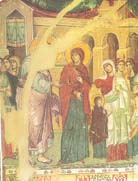 |
THE ENTRANCE OF THE THEOTOKOS
A magnificent masterpiece composed by Panselenos. In spite of the damages it has undergone, it preserves all the vividness, realism and emotion of the Entrance of the Theotokos. It shows the temple and at the edge an entryway with three stairsteps. The Prophet Zacharias is standing in the entryway with hierarchical vestments, stretching out his hands foreward; the All-holy Lady as a three-year-old, ascends the steps in front of him, with one hand stretched out towards him and the other holding a taper; while behind her Joacheim and Ann, look at each other and point at her. Beside them is a multitude of taper-bearing virgins, while at the top of the temple is a beautiful canopy, within which the All-holy Lady is sitting, receiving the bread which the Archangel Gabriel is bringing her, blessing her (Dionysios of Phournas). The face of Joacheim has been entirely destroyed. The presentation of Gabriel with the All-holy Lady has also undergone severe damage.
|
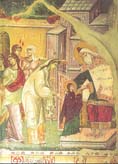 |
|
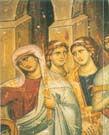 |
Women, a detail from the masterpiece fresco of work no. 47. The arrangement of the figures, the profiles of the faces, the mobility and the purity which distinguish them bear witness that the artist was not simply a great portrait painter, but one of the most incomparable, dynamic craftsmen out of all the most significant artists in the sum total of Greek art. It is also a daring presentation of women in the very heart of the Hagiorite retreat into solitude.
|
 |
|
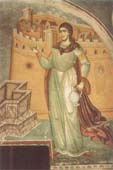 |
SAINT PHOTEINE THE SAMARITAN
Saint Photeine, the Samaritan woman who spoke with Christ at the well, became a martyr together with her five brothers and two sons during the reign of Nero (54-68), according to Saint Nicodemus the Hagiorite. Sophronios Eustratiades categorically rejects this tradition as fictional. Behind her the craftsman gives sufficient depth to the composition with the representation of the walls. And this presentation, in which the feminine grace of Saint Photeine stands out, is striking amidst the austere forms of the hermits, ascetics, stylites and other monks that Panselenos portrays in the Protaton.
|
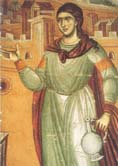 |
Detail of work no. 49, which projects the movement of Saint Photeine's right hand, while the stance and inclination of her body betray liveliness and palpability in the woman approaching the well with her pitcher in order to take water.
|
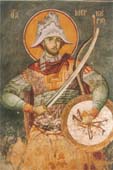 |
SAINT MERCURIOS
One of the handsomest and finest military saints that Panselenos portrayed in the Protaton. He came from Cappadocia and had been inducted into the army of the Martenses during the time of Decius (249-251) and Valerian (251-259), reaching the rank of general at the age of 25, by reason of his heroic exploits on the field of battle.
He was of Scythian descent, "young, handsome, blond, tall and distinguished in appearance" (Sophronios Eustratiades). He was martyred for admitting his faith in Christ. Terrible tortures were in store for him: scourgings, stabbings, burning in fire and finally, beheading by the sword. All the saint's purity is etched in his figure. He is holding a sword, bow and shield.
|
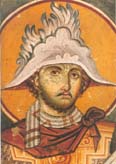 |
The head of Saint Mercurios, a detail of work no. 51. The martyr's short beard emphasizes his youthfulness, the Scythian helmet his background, and the rich clothing his high office.
|
 |
SAINT PROCOPIUS
The saint holds the spear diagonally in his right hand. A duke of Alexandria during the reign of Diocletian (284-304), he was originally from Jerusalem. His father, Christopher, was a Christian. The saint himself confessed Christianity after seeing a vision, while he was travelling from Alexandria on Diocletian's orders, to persecute the Christians. His own mother, who continued a pagan, accused him to Ulcius the governor of Caesarea. He was beheaded after horrible tortures because he refused to sacrifice to idols.
|
 |
SAINT EYSTATHIOS THE GREAT-MARTYR
He was called Placide and was a general in Rome. He converted to the Christian faith through a divine sign. While he was hunting he saw a hart that had a cross between its horns and he heard a voice calling him to the true faith. He was baptized with the name Eustathios and his wife Tatiana followed him, receiving the Christian name Theopiste, as did their two sons likewise. On a journey he lost both his family and his means of livelihood and was compelled to beg in order to stay alive. They restored him to his troop, however, and after the victory he won, he was reinstated in his former office, while at the same time his family was found again. During the time of Adrian (117-138), because he refused to sacrifice to idols, he met martyrdom with his entire family.
In the fresco by Panselenos an afflicted countenance co-exists with the austerity of a general. The spear he holds in his right hand indicates his military profession. A bit of damage to his hair does not alter contemplative form.
|
 |
SAINT AUXENTIOS
One of the five martyrs (Eustratios, Auxentios, Eugene, Mardarios, Orestes), whose memory is celebrated on December 13th. They were martyred during the persecutions of the Christians under Diocletian (284-304) and Maximian (286-305).
After terrible tortures, the martyr Auxentios was beheaded and his head was nailed high up in a tree, above which a raven hovered crowing, thus revealing where the relic was to the Christians. About Eustratios see no. 56.
|
 |
SAINT EYSTRATIOS THE WONDERWORKER
One of the five martyrs (Eustratios, Auxentios, Eugene, Mardarios, Orestes), whose memory is celebrated on December 13th. They were martyred during the persecutions of the Christians under Diocletian (284-304) and Maximianos (286-305).
The saint was subjected to awful tortures, being forced to walk on shoes made of nails. Concerning Auxentios see no. 55.
|
 |
SAINT THEODORE OF TYRON
He lived during the time of Maximianos (286-305), Gallerius (305-311) and Maximinus (305-312). His origin was Choumialon of Amasia. He followed the military course in the order of the newly inducted ("tyron" means "newly inducted soldier") under the Praepositus Vrigas. For burning the heathen temple of Rea he was arrested and hung. Afterwards they rent his body and threw it into the fire. He has been numbered among the great-martyrs. One of the most imposing of Panselenos' military saints, he holds his spear in his right hand diagonally across his chest.
|
 |
The head of Saint Theodore of Tyron, a detail of work no. 57.
|
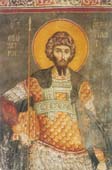 |
SAINT THEODORE STRATILATES
He lived in the time of Licinius (307-323). He was from Euchait (Marsivan in Asia Minor, presently Turkey) and dwelt in the city of Heracleia Pontica, where he was especially renowned for his nobility and heroism. Licinius wanted to make him sacrifice to idols, and he took the gold and silver statuettes home, supposedly in order to honor them, but shattered them instead and distributed them to the poor. This became known to the centurian Maxentius, who accused him to Licinus; he in turn ordered that Saint Theodore be imprisoned and tortured. After awful tortures, he was crucified.
He holds an upright spear in his right hand.
|
 |
The head of Saint Theodore Stratilates, a detail of work no. 59.
|
 |
CHRIST IN A DIFFERENT FORM
This has undergone significant damage. In spite of the atypical hair, nevertheless in this portrayal, in which the identity of Christ is manifested by the Cross in the halo, the facial characteristics refer us to the more well-known representations of the God-man. Photograph by Paul Mylonas.
|
 |
SAINT PAUL OF XEROPOTAMOU
As Sophronios Eustratiades mentions, the Hagiorite tradition has him as a contemporary of Saint Athanasios the Hagiorite and abbot of the Monastery of Xeropotamou. Another tradition treats him as a eunuch from a young age, and perhaps for this reason he is portrayed with white hair and the face of a youth with wrinkles. The "New Eclogion" mentions this tradition and has him as the founder of the Monastery of Xeropotamou.
|
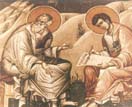 |
SAINT JOHN THE THEOLOGIAN DICTATING TO HIS DISCIPLE PROCHORUS
The beloved disciple of Christ dictates to his own disciple Prochorus. This fresco is found above the portraits of Saint Mercurius and Saint Artemios. Prochorus sits opposite the Evangelist and writes on his lap. The natural environment with its low green hills calls to mind the island of Patmos, where Saint John the Theologian wrote Revelations.
|
|

